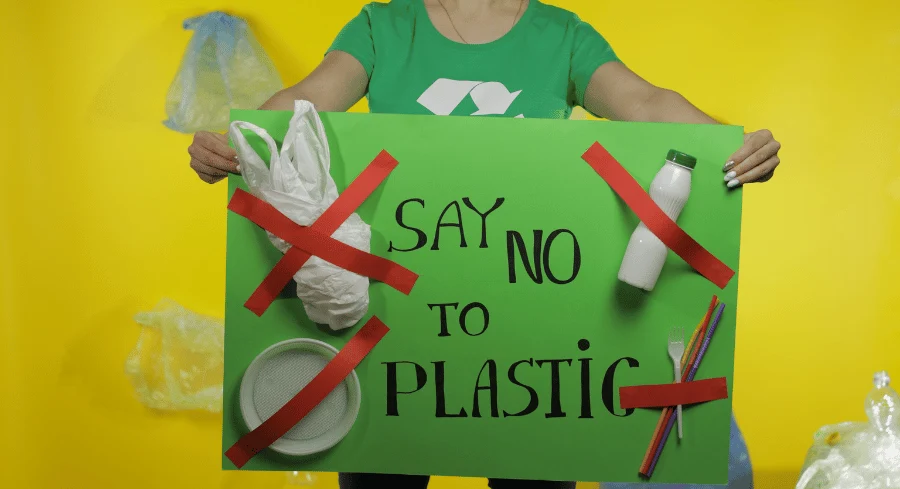Say ‘NO’ to Plastics, Embrace Alternatives
By Tahira Utsa
October 8, 2023
Update on : October 10, 2023

My heart sank when I came across a photo taken by renowned underwater photographer Jordi Chias published in The Guardian, where accumulated non-biodegradable plastic bars prevented a small turtle from reaching the surface. The photo featuring a Mediterranean Sea turtle entangled in a drifting abandoned net perfectly described the drastic human-fueled pollution that is speeding up ecological imbalance in the world.
Plastics are one of the most dangerous human inventions because they not only hold their form for decades but also threaten the biodiversity of this planet.
Plastic pollution is one of the most alarming environmental threats, as its improper disposal has led to the untimely deaths of millions of animals. As plastics do not decompose, they end up in various food chains, causing health hazards.
However, more natural and environmentally friendly alternatives to plastics are readily available. Let us take a look at a few such materials that can be a good alternative to this harmful substance.
Paper and cardboard
Paper and cardboard have been used as alternatives to plastic for quite some time, notably in the field of packaging.
These materials are both recyclable and biodegradable and may be replenished. The development of water-resistant coatings and treatments has increased the versatility of these materials, making them better suited for a variety of applications as technology has advanced.
However, Concerns have been raised as the production of cardboard results in deforestation. However, these difficulties can be avoided by recycling and making sure that raw materials are sourced ethically.
Glass and metal
Covers, utensils, and cutlery made with glass and metal are more durable than plastic.
Glass can be recycled indefinitely without any degradation, which significantly cuts down on the demand for the generation of new materials. And, in comparison to plastics, metals like aluminium are more easily recycled and leave behind a smaller carbon footprint.
However, factors like weight, shipping expenses, and energy-intensive production processes prevent the technique from being widely used.
Promotion of reusable containers and raising recycling rates may increase the environmental advantages these substances offer.
Bamboo
There are many ways to use bamboo, a versatile and ecologically amiable material, to lessen the use of plastic. Bamboo can be a substitute for blister packs, plastic wraps in packaging.
Packaging made from bamboo is renewable, compostable, and biodegradable, making it a more environmentally friendly choice. Its durability and resilience make it a preferred material for a wide range of products, including consumer goods, cosmetics, and food packaging.
One of the most frequently discovered waste products in the environment is plastic straws. A reusable and biodegradable substitute could be thin bamboo canes.
Alongside being a sustainable option for drinking liquids, these straws are manufactured from hollowed-out bamboo stalks, making them strong, easy to clean, and able to serve multiple purposes, which can lessen the need for single-use plastic straws.
Compostable materials
Compostable materials are designed to decompose into organic matter under specific conditions, providing a sustainable alternative for single-use items.
Compostable products, like food containers and cutlery, can be made from plant-based materials such as cornstarch and sugarcane. When composted in industrial facilities, these materials break down into nutrient-rich soil, contributing to a circular economy.
However, challenges remain regarding consumer awareness, infrastructure limitations, and the distinction between compostable and biodegradable products.
Natural fibers and plant-based materials
An eco-friendly alternative to plastic packaging is packaging made from natural fibers and plant-based materials. There is less need for products made of synthetic materials because packaging can be manufactured by weaving and molding materials like jute and hemp.
These options offer sustainable alternatives that have less influence on the environment and are either biodegradable or compostable.
For widespread acceptance, however, adaptability, durability, and cost-effectiveness are crucial factors to take into account.
Edible and water-soluble packaging substitutes
Edible packaging, which can be created from materials such as seaweed or starch-based things, offers a novel alternative to conventional plastic packaging. As these components can be used directly in the finished product, they generate no waste, and soluble packaging produced from polymers like polyvinyl alcohol dissolves as soon as it comes into contact with moisture, which makes it very easily decomposable.
Even though these options have shown some potential, there is still a need for additional research into issues such as shelf life, safety, and customer acceptance.
Ceramics
Ceramics are typically thought to be more environmentally friendly when compared to plastics.
Ceramics are renowned for their extreme toughness and resistance to damage. Ceramics are ideal for long-lasting products, especially in the kitchen, as they have a high lifespan, unlike plastic, which can deteriorate with time.
Usually non-toxic, ceramics do not release poisonous materials when heated or subjected to other environmental variables. Ceramics are a safer alternative to some plastics because they don’t include additives or chemicals that can leak into food or the environment.
It’s important to keep in mind that not all plastic applications can be perfectly replaced by ceramics. As they can be heavier and more delicate than plastic, the use of ceramics may be limited in particular circumstances. Additionally, the processes used to make ceramics may require more energy than those used to make some types of plastic.
Clay pots
Clay pots typically provide the kitchen or dining table a traditional and rustic atmosphere due to their beautiful appearance. They can be used as serving utensils and ornamental items, enhancing the food’s overall presentation.
Clay pots are made from natural clay, which is a renewable resource. Clay is one type of environmentally friendly material that has a little negative impact on the environment as it easily degrades over time and is biodegradable.
Clay pots don’t include any harmful ingredients or additives that could contaminate food or liquids. Plastic containers, especially those of low quality or composed of questionable materials, may leak poison when exposed to heat or acidic liquids.
Using clay containers for food preparation or storage reduces the likelihood of chemical contamination.
Behavioral shifts and innovative solutions
In addition to using different kinds of materials, one way to help curtail plastic use is to encourage people to adopt new behaviors and look for inventive solutions.
Products that can be reused, such as tote bags made of cotton, straws made of stainless steel, and containers that can be refilled, encourage environmentally responsible behaviors.
Furthermore, new techniques, such as stores that do not use packaging, refill stations for bulk items, and models of circular economies, promote the reduction of waste and the efficient use of resources.
Biodegradable plastics
These materials present a viable replacement for conventional plastics.
These substances are made to be decomposed spontaneously by microbial activities, which lessen their ability to remain in the environment.
Different materials, including plant-based polymers (like polylactic acid) and microorganisms, can be used to make biodegradable plastics. To assure efficient disposal, there are, however, issues pertaining to cost, flexibility, and the right waste management infrastructure.
As society becomes more aware of the urgent need for sustainable solutions, the search for plastic substitutes is speeding up. Addressing issues including cost, capacity, waste management infrastructure, and consumer awareness is still essential, though.
We can get closer to a day when sustainable and environmentally friendly alternatives to plastic pollution will be used by embracing the aforementioned alternatives and encouraging research and innovation.
Read more: Say ‘NO’ to Plastics, Embrace Alternatives














